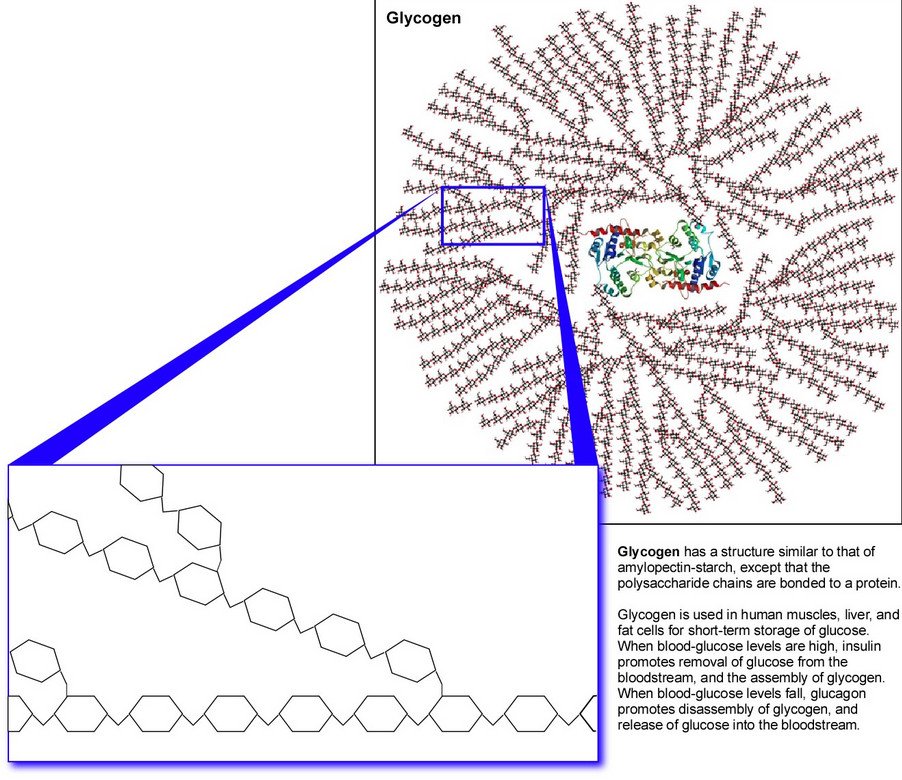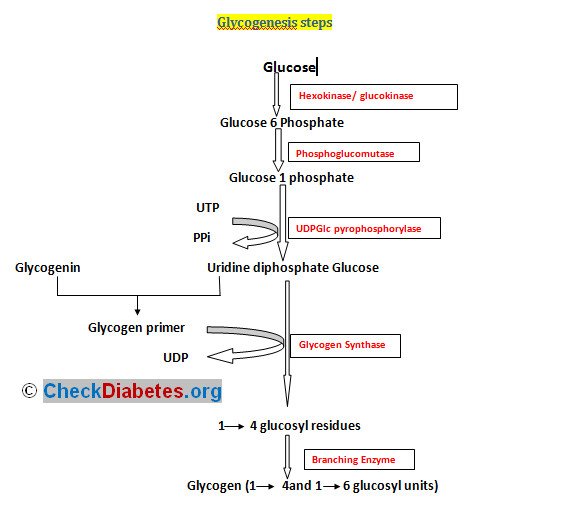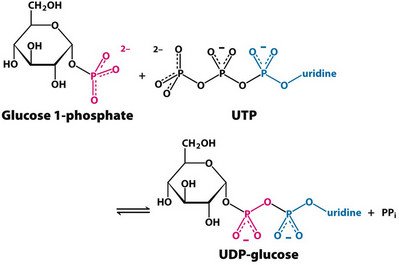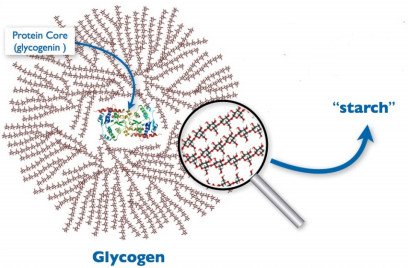Glycogenesis Definition
Glycogenesis is the biosynthesis of glycogen, the major storage form of carbohydrate in animals similar to starch in plants.
Glucose is the major source of energy to the cells. Glucose and its precursors like starch are supplied through the food we eat and are not reliable and continuous sources.
Therefore our body has a built in mechanism which stores the excess carbohydrates we consume, in the form of glycogen which could be broken down to glucose when needed.
Glycogen comes to rescue when the blood glucose drops down, a situation which prevails between our daily meals. The major sites of storage of glycogen are liver and muscle. Although the glycogen content of liver is greater than that of muscle, three quarter of total glycogen is stored in muscles due to their mass. [1, 3]

Picture 1: Glycogen diagram
Image source: courses.bio.indiana.edu
What is Glycogen ?
Glycogen is a homopolymer made up of repeated units of α D glucose and each molecule is linked to each other by 1→4 glycosidic bond which is a link connecting the 1st C atom of the active glucose residue to the 6th C atom of the approaching glucose molecule.
Once there is a chain consisting of 8 to 10 glycosidic residues in the glycogen fragment, branching begins by 1→6 linkages. Liver glycogen is synthesized in well fed states. Muscle glycogen is synthesized when the muscle glucose get depleted in intense physical exercise. [1, 2, 3]

Picture 2: Chemical structure of glycogen
Diagram Source: tutorvista.com
Glycogenesis Pathway
Glycogenenesis pathway is made up of series of steps resulting in the formation of complex glycogen molecule from α D glucose in the cytoplasm of liver and muscle cells. .
Glycogenesis Steps

Gluconeogenesis Steps
UDP glucose – Synthesis of the carrier molecule:
UDP glucose acts as a vehicle that carries the glucose molecule which is to be added to the budding glycogen molecule. UDP molecule and glucose 1 phosphate react in the presence of UDP glucose pyrophosphorylase to form UDP glucose.

Picture 3: Synthesis of UDP glucose
Diagram Source: oregonstate.edu
Glycogen primer
Glycogen synthesis cannot start from scratch. It needs a basic molecule on which the glucose residues can be added so that the chain can get elongated. Glycogen fragments which already exist can act as this primer. In glycogen depleted condition, a protein primer called glycogenin acts as the flooring to which the glucose molecules from UDP glucose are added like bricks.
During the initial additions of glucose molecule, glycogenin acts as an auto catalyst and forms the glycogen fragment on which further glucose residues are added by 1→4 linkage by the enzyme glycogen synthase.
Elongation of glycogen chain:
The UDP glucose transfers the glucose molecule to the growing glycogen chain in such a way that a link is formed between the 1st C atom of the standing glucose residue on the end point of the fragment and 4th carbon of the glucose residue that is being added to the fragment.
This forms the 1→ 4 glycogenic link. The enzyme catalysing this step is glycogen synthase. [2, 3]
Branching in glycogen
If Glycogenesis stops with the above steps, it is expected to create a long linear molecule similar to that of starch in plant. But this is not the case. After around 8 residues, branching begins and the branches provide more number of activated glucose residual ends for the UDP glucose to get attached to.
This results in a highly branched easily soluble glycogen molecule. This branching is brought about by branching enzyme called amylo-α(1→4) → α(1→6)-transglucosidase.
The function of this enzyme is to break a fragment of glycosyl residues at the 1→ 4 linkage and attach them to another glucose molecule on the chain, to form the branching points, by α(1→6) linkage. This results in more number of end points for UDPglucose to add further glucose residues to it. Thus branching enzyme results in extensively branched large glycogen molecule.
Defect in glycogen synthesis and glycogen degradation results in accumulation of abnormal glycogen inside a cell which leads to glycogen storage disorders. One such genetic disease is Glycogen storage disorder type 4 called as Anderson disease caused by defective branching enzyme.
So the glycogen formed is a linear insoluble structure that accumulates in the cells causing liver and muscle damage..[ 9,10,11]

Picture 4: Branched glycogen vs. linear starch
Diagram Source: bioserv.fiu.edu

Picture 5 : Glycogen molecule
Regulation of Glycogenesis
Glycogen synthesis is strictly monitored to regulate the blood glucose level. It is activated in well fed state and suppressed in fasting. According to basis of regulation of metabolic process, the factors regulating Glycogenesis are
Availability of substrate
In well-fed state, when the blood glucose level is high, glucose 6 phosphate the substrate for UDP glucose is also high. This allosterically increases Glycogenesis. Also during fasting, the substrate is low and there is need for glucose which causes break down of glycogen which is opposite of Glycogenesis. [3]
Hormone:
Glycogen synthase, the key enzyme of Glycogenesis exists in activate (dephosphorylated) and inactive (phosphorylated) form. Hormones like glucagon and epinephrine are diabetogenic i.e. they increase the blood glucose level.
Thus they antagonize glycogen synthesis which is an effective way of reducing blood glucose level and storing it for further use.
These hormones succeeds in their function by series of biochemical reactions which results in phosphorylation of glycogen synthase enzyme rendering it inactive.[2]
Insulin is an ant diabetic hormone. It lowers the blood glucose level by stimulating the uptake of glucose by muscle cells and Glycogenesis in liver and muscle.[4]
Difference between Glycogenesis and Glycogenolysis
| GLYCOGENESIS | GLYCOGENOLYSIS |
|---|---|
| Synthesis of glycogen from glucose | Break down of glycogen to glucose |
| Stimulated by increased blood glucose level as in well fed state, insulin | Stimulated by fasting, between meals physical exercise, glucagon, epinephrine |
| Inhibited by glucagon, epinephrine | Inhibited by insulin |
| Glycogen synthase is the key enzyme which is dephosphorylated in active form | Glycogen phosphorylase is the key enzyme which is phosphorylated in its active form. |
Difference between Glycogenesis and Gluconeogenesis
| GLYCOGENESIS | GLUCONEOGENESIS |
|---|---|
| Synthesis of glycogen from glucose | Synthesis of glucose from non carbohydrate substrates |
| Stimulated by increased blood glucose level as in well fed state, insulin | Stimulated by low glucose levels like starvation, acidosis, glucagon and glucocorticoids |
| Inhibited by glucagon, epinephrine | Inhibited by insulin |
| First step is synthesis of UDPGlc | First step is Pyruvate |
| Key enzyme is Glycogen synthase | There are 4 key enzymes – Pyruvate carboxylase, Phosphoenol pyruvate carboxykinase, Fructose 1, 6 bisphosphatase and Glucose 6 phosphatase |
| Occur in liver and muscle | Occur in liver and kidney |
Glycogenesis Animation
See here : Link
References:
- Harper’s Illustrated Biochemistry 28/e Metabolism of glycogen
- http://en.wikipedia.org/wiki/Glycogenesis
- Lippincott’s Illustrated Reviews Biochemistry 4/e Intermediary metabolism
- http://www.britannica.com/EBchecked/topic/1540414/glycogenesis
- http://academic.mu.edu/bisc/siebenlistk/3213gluconeogenesis_etal.pdf
- http://www.rpi.edu/dept/bcbp/molbiochem/MBWeb/mb1/part2/gluconeo.htm
- Biochemistry notes – usmle step 1
- http://aippg.net/threads/which-of-the-following-hormones-stimulates-gluconeogenesis.96376/
- http://emedicine.medscape.com/article/1116574-overview#a0104
- http://ghr.nlm.nih.gov/condition/glycogen-storage-disease-type-iv
- http://www.dukechildrens.org/services/medical_genetics/glycogen_storage_disease_types



excellent presentation